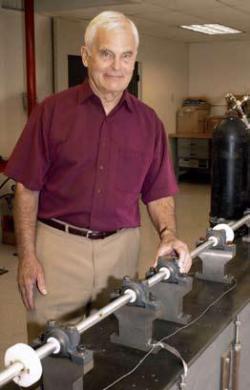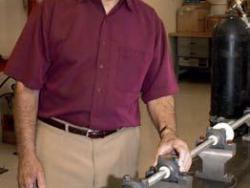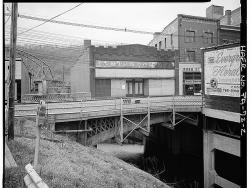This machine, designed by Alton S. Newell, efficiently reduced automobile bodies into scrap metal for recycling. A body was fed into the shredder at a controlled rate, and rotating hammers, driven by a 500-hp motor, shredded it into small pieces that were easily shipped. The process took about 10 minutes a car and used less energy than other shredding and crushing machines.
Metal


Not only was Dunlap's Creek Bridge the first cast-iron bridge in America, it was the first metal bridge anywhere to use what its builder, Capt. Richard Delafield, U.S. Army Corps of Engineers, described as "standardized, interchangeable, manufactured parts." The bridge was built as part of the federal government's effort to make repairs on the National Road before handing authority over to the states. Dunlap's Creek at Brownsville was an especially troublesome crossing, having destroyed three previous bridges since 1801.

The Southwest Research Institute Split-Hopkinson Pressure Bar apparatus is a mechanical test instrument used to characterize the dynamic response of materials at high strain rates (typical of impacts and explosions).
The apparatus, based on devices invented by Bertram Hopkinson and Herbert Kolsky, was developed at SwRI in 1962 by Dr. Ulric Lindholm. Initially created to evaluate the behavior of metals under various conditions, the SwRI Split-Hopkinson Pressure Bar has since been applied to a wide range of materials.
Innovations

The Southwest Research Institute Split-Hopkinson Pressure Bar apparatus is a mechanical test instrument used to characterize the dynamic response of materials at high strain rates (typical of impacts and explosions).
The apparatus, based on devices invented by Bertram Hopkinson and…
Read More
Not only was Dunlap's Creek Bridge the first cast-iron bridge in America, it was the first metal bridge anywhere to use what its builder, Capt. Richard Delafield, U.S. Army Corps of Engineers, described as "standardized, interchangeable, manufactured parts." The bridge was built as part of…

This machine, designed by Alton S. Newell, efficiently reduced automobile bodies into scrap metal for recycling. A body was fed into the shredder at a controlled rate, and rotating hammers, driven by a 500-hp motor, shredded it into small pieces that were easily shipped. The process took about…
Read More

